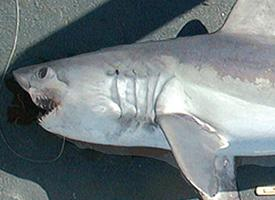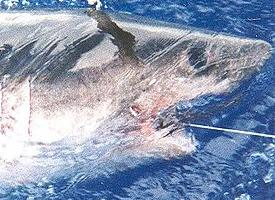
Veszélyeztetettség
| Veszélyeztetett |
Állatleírás
The Great White Shark (Carcharodon carcharias), often simply known as the great white, is one of the ocean's most well-known and feared predators. This magnificent creature has roamed the world's oceans for millions of years, inspiring a mixture of fascination and fear in humans. With its torpedo-shaped body, powerful tail, and infamous dorsal fin cutting through the water's surface, the great white shark is an apex predator, sitting at the top of the marine food chain.Adult great white sharks can grow to lengths of up to 20 feet (6 meters), although most are smaller, averaging around 15 feet (4.5 meters). They can weigh as much as 5,000 pounds (2,268 kilograms), with females generally larger than males. Their bodies are streamlined for efficient travel through water, with a powerful caudal (tail) fin that propels them at speeds of up to 15 miles per hour (24 kilometers per hour). Their skin is a rough, gray color on the top, which helps them blend in with the ocean floor when viewed from above, and a stark white underneath, making them harder to see from below against the bright surface light.
One of the most distinctive features of the great white shark is its mouth. It is lined with several rows of sharp, triangular teeth that can measure up to 2.5 inches (6.4 centimeters) in height. These teeth are designed for tearing flesh and are continuously replaced throughout the shark's life. Great whites are carnivorous and have a varied diet that includes fish, rays, other sharks, and marine mammals such as seals, sea lions, and sometimes whales. They are known for their "breach" hunting technique, where they attack their prey from below with such force that they propel themselves out of the water.
Despite their fearsome reputation, great white sharks are not indiscriminate "man-eaters." Most human encounters with great whites occur because the shark mistakes the person for its usual prey. These sharks have a curious nature and often "sample bite" before releasing their target, though even a single bite can be grievously injurious or fatal to humans due to the shark's size and power.
Great white sharks are found in cool, coastal waters all over the world, from the coast of Australia to the shores of South Africa, the Mediterranean Sea, and the northern and eastern coasts of the United States and beyond. They are mostly solitary animals, coming together only for breeding or in areas of abundant food sources.
Conservation status of the great white shark is currently listed as Vulnerable by the International Union for Conservation of Nature (IUCN), due to overfishing, accidental catches in fishing gear, and their slow reproductive rate. Great whites give birth to live young, a process known as ovoviviparity, and can take up to 15 years to reach sexual maturity. They are known to live up to 70 years, possibly longer, but their slow reproduction rates make their populations vulnerable to decline.
In recent years, great white sharks have become the focus of conservation efforts and scientific research. They play a crucial role in the marine ecosystem by helping to keep the populations of other species in check. By understanding more about these magnificent creatures, their behavior, and their habitat, conservationists hope to protect them and ensure they remain a vital part of the ocean's ecosystem for generations to come.
Hasonló állatok
Új állatfotók
Top 10 állat
- Dolphin gull (Leucophaeus scoresbii)
- Diana monkey (Cercopithecus diana)
- Moustached guenon (Cercopithecus cephus)
- Galápagos tortoise (Geochelone nigra complex)
- Japanese macaque (Macaca fuscata)
- Russian tortoise (Testudo horsfieldii)
- Stone loach (Barbatula barbatula)
- Greek tortoise (Testudo graeca)
- Common flying dragon (Draco volans)
- Vendace (Coregonus albula)


